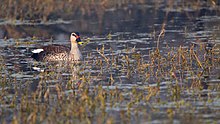Anas poecilorhyncha
| Spot-billed duck | |
|---|---|
 |
|
| Indian spot-billed duck (A. p. poecilorhyncha) |
|
| Scientific classification | |
| Kingdom: | Animalia |
| Phylum: | Chordata |
| Class: | Aves |
| Order: | Anseriformes |
| Family: | Anatidae |
| Subfamily: | Anatinae |
| Genus: | Anas |
| Species: | A. poecilorhyncha |
| Binomial name | |
|
Anas poecilorhyncha Forster, 1781 |
|
| Subspecies | |
|
|
The spot-billed duck (Anas poecilorhyncha) or spotbill, is a dabbling duck which breeds in tropical and eastern Asia. It has three populations, treated here as subspecies, the Indian spot-billed duck (A. poecilorhyncha poecilorhyncha), Eastern or Chinese spot-billed duck (A. poecilorhyncha zonorhyncha), and Burmese spot-billed duck (A. poecilorhyncha haringtoni). Some authors elevate the eastern population as a species, Anas zonorhyncha. The name is derived from the yellow and red spot on the bill.
This duck is around the same size as a mallard and has a scaly patterned body with a green speculum bordered by white. At rest the white stripe stands out and the long neck and the bill with yellow tip and orange red spots at the base are distinctive in the nominate subspecies. The white border is missing in zonorhyncha and the red spots at the base of the bills are absent in zonorhyncha as well as haringtoni. It measures 55–63 cm (22–25 in) in length and 83–95 cm (33–37 in) across the wings, with a body mass of 790–1,500 g (1.74–3.31 lb). These are mainly grey ducks with a paler head and neck and a black bill tipped bright yellow. The wings are whitish with black flight feathers below, and from above show a white-bordered green The male has a red spot on the base of the bill, which is absent or inconspicuous in the smaller but otherwise similar female. The male does not have an eclipse plumage. Juveniles are browner and duller than adults. The legs and feet are bright orange.
The eastern spot-billed duck is darker and browner; its body plumage is more similar to the Pacific black duck. It lacks the red bill spot, and has a blue speculum.
Both males and females undergo a complete postnuptial moult, dropping all their wing feathers simultaneously.
This duck is resident in the southern part of its range from Pakistan and India to southern Japan, but the northern subspecies, the eastern spot-billed duck (A. p. zonorhyncha), is migratory, wintering in Southeast Asia. Some individuals of the nominate population may also move. A bird ringed at Bharatpur in Rajasthan on 5 December 1969 was recovered near Novosibirsk in August 1970. It is quite gregarious outside the breeding season and forms small flocks. The northernmost populations have expanded their range northwards by more than 500 km since the early 20th century, possibly in reaction to global warming.
...
Wikipedia

